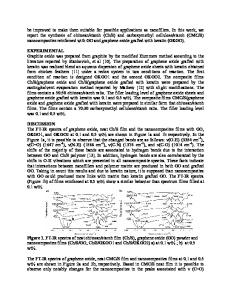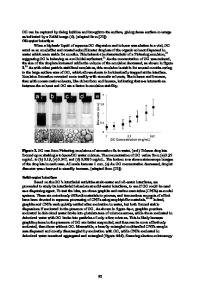Towards industrialization of graphene oxide
- PDF / 1,074,319 Bytes
- 9 Pages / 595.276 x 793.701 pts Page_size
- 61 Downloads / 284 Views
Published online 9 July 2019 | https://doi.org/10.1007/s40843-019-9462-9
Towards industrialization of graphene oxide 1
1
Yufei Ma , Yaxuan Zheng and Yanwu Zhu
2*
ABSTRACT Graphene oxide (GO) has demonstrated potential applications in various fields, and attracted intensive attention in industry as well. Numerous companies worldwide have been working on the industrial applications of GO-based materials in, e.g., thermal management, multifunctional composites, anti-corrosion paints, lubricants, energy storage, environment protection and biomedicals. This review presents a short summary on the proceedings of GO towards industrialization, including the large-scale production and some promising applications, by providing views on the processing strategies and challenges specifically for the industrial use of GO. This review would help the scientists in this area to find topics for overcoming challenges together with engineers. Keywords: graphene oxide, mass production, industrial application
INTRODUCTION Graphene oxide (GO), a monolayer analog to graphene but with rich oxygen-containing groups on the carbon skeleton [1–3], has witnessed an intensive research boom worldwide in the past decade. GO has been considered as one of the most promising precursors to produce graphene materials at industrial scale and other applications of interest for several reasons. First, single-layered GO platelets can be readily manufactured through the exfoliation of graphite oxide in numerous solvents. This has triggered a huge amount of research on the assembly of such nanoplatelets to macroscopic structures such as fibers, films and aerogels. Secondly, the abundant functional groups on GO allow versatile chemical modifications for a wide range of applications, especially for hybridizing GO. Thirdly, the excellent dispersibility of GO in water and some organic solvents makes the processing based on the current chemical engineering facility 1 2
*
possible, which is critical to constantly lower the cost of GO. In addition, the de-oxidization (typically called reduction) of GO, which is often needed to partially recover the conjugate structure and some properties (e.g., electrical or thermal conductivity), can be carried out simultaneously with the processing mentioned above under many circumstances, increasing the flexibility of GO used in final products. Therefore, numerous companies are encouraged to enter GO-related markets to commercialize the preparation and some applications proposed by scientists. Understanding the structure of GO is essential for the appropriate utilization of GO. Generally, GO is composed of carbon, oxygen and hydrogen atoms, among which the oxygen atom is mainly in the form of carboxyl, hydroxyl, ketone and epoxy groups. With magic angle spinning nuclear magnetic resonance (MAS NMR), Lerf and Klinowski (LK) model [4] demonstrated that the epoxy and hydroxyl groups were on the GO plane, while carboxyl and hydroxyl groups were at the edges. In LK model, two 2 kinds of carbon domains are present in GO: sp car
Data Loading...











